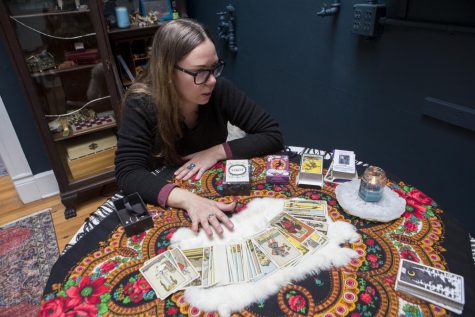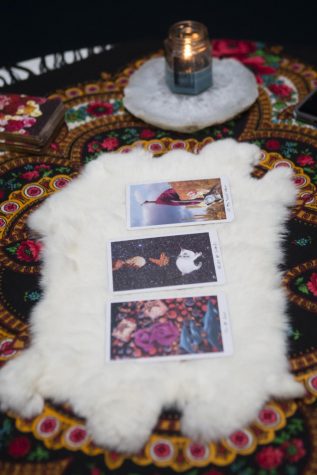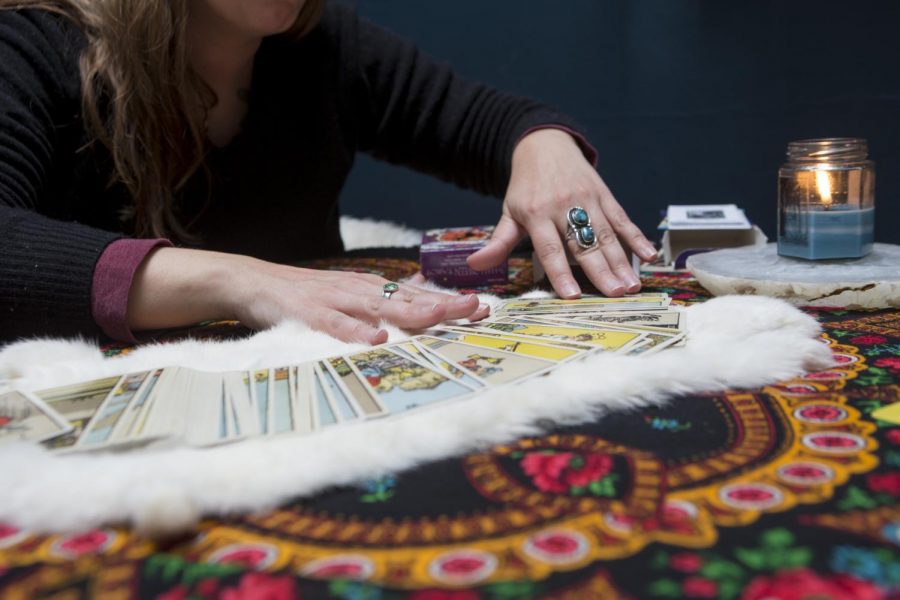It’s in the cards: tarot reading in Iowa City
The earliest discovered tarot decks date back to the late fourteenth century, but its use as a tool for divination remains alive and relevant in Iowa City today.
Dawn Frary shows a deck of tarot cards on Saturday, Oct. 12, 2019. Frary performed a demonstration tarot reading at Over the Moon Studio, a shared workspace downtown. (Emily Wangen/The Daily Iowan)
October 16, 2019
With an amethyst cluster to my right, clear quartz placed delicately behind my back, a pillar of selenite on my left, and an orb of opal set just out of sight, I sat cross-legged within a diamond-shaped formation of focused energy. Across from me sat Bridget Baltazar, a second-year student at the University of Iowa. A full set of tarot cards sat patiently stacked between us.
In the dim light of her small dorm, I was instructed by Baltazar to cut the tarot deck once, and then again, into three descending stacks that would soon dictate the beginning, middle, and end of my week. Although this was not my first tarot reading, I still felt a twinge of excitement — and fear — of discovering what my future held.
The use of tarot cards dates back to the late 14th century, where some of the first known decks have been discovered in northern Italy. While then they were used to play games such as Italian tarocchini, tarot later developed as a form of divination, allowing tarot readers to use the cards to interpret problems or general developments in a person’s life. Baltazar provides readings for herself each morning and for other students in her residence hall who visit her dorm.
All tarot decks consist of the same 78 cards, separated into three categories: the Major Arcana, which signify major lessons or energies; the Minor Arcana, which provide details to those lessons or energies; and the four suits: cups, swords, wands, and pentacles.
Baltazar gracefully flipped over the first glossy purple card of my reading, revealing the Eight of Pentacles, and began to interpret. Using a small book that had come with the deck as a guide, she informed me that at the beginning of my week there would be the birth of a new project or the advancement of an idea. I smiled and let out a quiet laugh, thinking of the research project I was planning to launch in one of my theater classes the following week — wondering if her interpretation could possibly mean that, or if it was simply a coincidence.
Like most other readers, Baltazar began learning to read tarot with the Rider Waite deck, which is one year away from celebrating its 100-year anniversary. From it, thousands of decks featuring different styles and artwork have sprouted, all while keeping the same Major Arcana, Minor Arcana, and suits.

“So many other decks grew out of [The Rider Waite] deck,” said Dawn Frary, owner of Folkloracle Tarot in Iowa City. “When they see this imagery, they know it’s tarot.”
According to Frary, the emergence of so many different decks is due to the individual connections tarot readers make with their cards. Both she and Baltazar recalled feeling drawn spiritually to certain decks when they sought them out in stores, and readers can more easily identify with the messages the cards convey depending on the artwork depicted on them.
“Going through [a] deck, you can know what the Page of Cups means and relates to, but the characters are not modern enough that people can really build a connection,” Frary said.
For Frary, she found herself drawn to one particular deck that depicts very visual and collage-esque images on its cards. She said she discovered readings she performed with the particular deck tended to be the most accurate, and she handles them with extreme care, not even allowing another person to come in physical contact with them.
“There’s something about this deck. When I first got it, I bonded with it more than any other deck I’ve used,” she said. “If I want clarity and accuracy, I know I can trust this deck.”
According to Jeet Saini, owner of Om Gifts for Body & Soul, located at 105 S. Linn St. in Iowa City, her store currently offers a selection of 300 to 400 different tarot decks with new decks arriving all the time. Many decks also feature artwork from local artists.
The cards Baltazar used for my reading came from a quantum tarot deck, which combines the suits and Arcana with space imagery and science.
While the cards themselves offer no magical properties, Illinois-based psychic Michael Jason Whitcomb, owner of Soul Empowerment, said they can be used as a tool for the reader to focus their interpretations.
“[The cards] help the individual who is reading the tarot to be able to see something physical and concrete in front of you,” he said. “It helps offer clarity when it comes to questions that you have about things that are coming or things related to the past.”
While there are no negative cards in tarot, Baltazar said some recipients can become fearful of what their cards may mean for them. My last card in her reading was the Eight of Swords, which could indicate a feeling of hopelessness and anxiety in a certain situation. I felt uneasy at the idea of an unknown concern possibly awaiting me in my near future, but was soon put at ease by Baltazar.
Baltazar said cards in the Major Arcana — which include cards Death, the Devil, and the Hanged Man — can seem frightening at first, but hold much lighter interpretations, including rebirth and changes in perspective. Discovering that my future situation would lead me to open my eyes and see a way out relieved me. Frary said it applies to the suits, as well.
“The Ten of Swords is being overburdened by your own mind until you hit rock bottom,” she said of a card I was examining from one of her many decks. “But then at the same time, from there, there’s nowhere to go but up. It’s all temporary.”
A single candle was lit in Frary’s small shared workspace in Over the Moon during my reading with her, the rest of the light spilling naturally from the ceiling window. The setting was the closest to my original expectations when I decided to seek out a tarot reader: a tiny, cozy office space tucked behind a neon green “Arcade” sign on Washington Street, the space decorated with patterned tapestries, an oddly-shaped arrangement of mirrors, and only furnished with a single wooden table in the center of the room.

But Baltazar is an example of the community of tarot-readers outside of the professional realm. While decks are often used by psychics and other readers for business purposes, Whitcomb said anyone can learn to read tarot for themselves and others as a means of reflecting on current, past, and future changes in life. And, according to Saini, plenty of people do.
“There is definitely a difference between a tarot reader and someone who is psychic,” Whitcomb said. “Tarot is just a tool.”
Whether used as a mindfulness tool, a fortune-telling tool, or simply an entertaining party trick, tarot-reading is certainly alive and well in modern day. Several tarot-related events, including classes and readings, occur around Iowa City each year. The area sees a particular spike around October and Halloween. Frary will hold a tarot-reading event at White Rabbit from 3 p.m. to 7 p.m. on Oct. 17, while Om Gifts for Body & Soul will offer a beginning tarot-reading class on Oct. 20 and readings on Oct. 27.
As for my cards, it was eerie how similar the two separate readings I received from Baltazar and Frary were. Where my reading for the week with Baltazar had ended with the Eight of Swords before, my reading with Frary began with the same card the following week, as though picking up where the past reading had left off as the course of my life continued to flow and change.
However, my readings were only a glimpse into the world of divination, and I felt a certain separation from my cards and the reading, whereas my readers appeared particularly connected. According to Frary, not everyone connects to their cards at first, particularly those who are receiving a reading out of curiosity rather than genuine interest in reflecting on what has passed and what is to come. Whatever came of my cards was not supposed to happen for certain. The cards described no specific events, but were rather to prepare me for what could come.
No matter what purpose a reading is used for, Baltazar said to take it in with an open mind. Doing so certainly helped me dive deeper into exploring a way to connect with the good and the bad, the true, the uncertain, and the ever-changing, all within what Frary calls “a language of symbols.”




